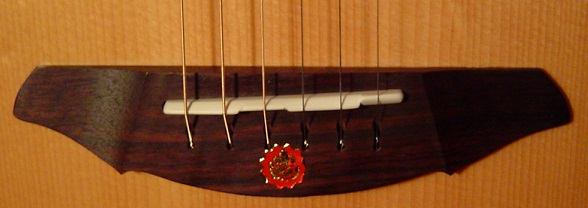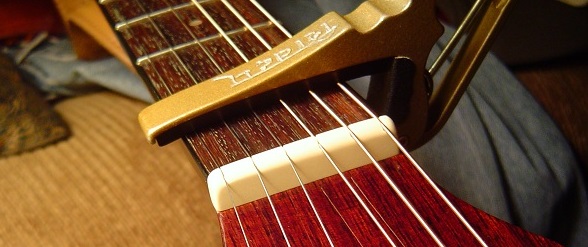Open A Tuning; Intonation for Open-tuned Guitars: String Gauges, Nuts and Saddles
by Shivadam Adam Burke, August 2013 and Wren Kothrade, December 2012
Wren Kothrade has written about what she describes as "the fastest tuning from standard to an open tuning":
I wanted to share with you the tuning I use. Instead of GGD, GGD, it's one full note up the scale to AAE,AAE. Below is a little chart of how to tune from Standard to this Tonic A tuning:
String # / Standard / Open A / Adjustment:
1 E E Remains the same
2 B A Tune down from B to A
3 G A Tune up from G to A
4 D E Tune up from D to E
5 A A Remains the same
6 E E Remains the same
The lowest string breaks the common pattern as it's not tuned to the tonic A, but instead is tuned to the dominant E. However, I find that I like having a nice low bass note and consider it to be like a drone note. I don't think it creates any problems with the chord patterns for open tuning, as I don't think the lowest string is included in playing chords. Should you ever find that you can only take one guitar with you somewhere, this seems the quickest tuning from standard to open. i also like it, as it's easy on the guitar itself. Anyhow, try it and see what you think. ...
I just stumbled upon it, and have not heard of anyone else using it. My thought is that the GGDGGD open tuning became popular with the dance community because so many of Sam's dances were written using mainly the two notes of G and D. I know that tuning to B flat became popular with the Montana community.... Why not just a half note lower and tune to A? For a situation with a single guitar, going back and forth in tuning from standard to open, it's ideal.
Improving Intonation on Guitars Dedicated to Open Tuning
When I can work with two guitars, I prefer to have one dedicated, customized for open tuning. Having converted one of my guitars - first to the Open G, then later to Open Bb - I soon felt the need to make a brand new saddle for this guitar in order to achieve better intonation across the strings along the span of the neck.
Some 6-string open tuning set-ups have strings tuned to the same note (at the same octave) employing differing string gauges and tensions, and - in the case of strings 2 and 3 - different materials (one steel, one wound bronze). This means that when you play these strings up the neck, they are not always perfectly in tune with each other.
This is especially true on guitars where the factory saddle is compensated for standard tuning, which is most guitars today. If you look at your guitar, you will probably find that the B string is set toward the back of the saddle by way of a special notch there. The purpose of that is to make the intonation of that string ideal for standard tuning. But in the case of the open-tuned guitar, even when strings 2 and 3 have been custom fitted with identical gauges and material, with the compensated factory saddle still in place, this pair still has different settings for intonation! Once again, the strings will not always be in tune as you play up the neck.
So, for my open-dedicated guitar, my solution was to shape a new saddle, to ensure that all the paired strings of the custom gauges (those tuned to the same notes) will have virtually identical intonation. I feel quite happy with the resultant sounds of the notes along the neck.

Additionally, with both the open Bb and open G tunings I have used, I fell it necessary to make a custom nut to fit the different-than-standard string gauges. This is a good idea for any guitar customized with differently gauged strings for special tunings.

After experimenting with these various tunings over several years, like Wren, I now like having the lower bass string (#6) tuned to the dominant, as in her Open A tuning or by changing to a lower string in other tuning set-ups. It serves as the beginning note for so many songs, and it also creates a third "track" for playing the "octaved" melody below the tonic.
Before I left the US to lead Dances of Universal Peace and Tara Dhatu's "21 Praises of Tara Mandala" music in Thailand and India in early 2013, Wren shared her Open A tuning with me, and it proved an ideal solution to my concern about having only one guitar for six weeks in Asia. I had already customized one guitar, my open-tuned guitar for the Bb tuning. So, what would I do for those few songs I absolutely wanted to play in standard tuning? Now with the knowledge of Wren's tuning, I took a standard guitar instead, and - without needing to change a single string or make any other modifications to the instrument - the guitar performed beautifully for all my musical needs during the tour - with only one exception: when asked to lead one final Dance, the G string snapped as I tried to tune back to A!
May all beings be happy and well!
Shivadam
|